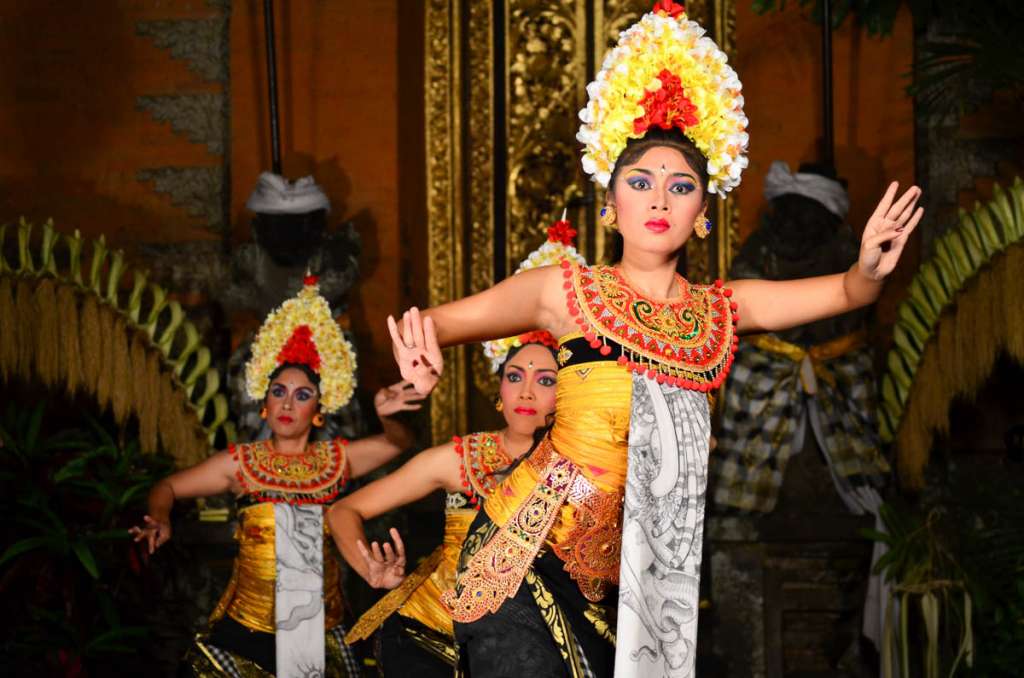The backbone of Balinese culture is dance, which is performed for the duration of temple festivals and in ceremonies of the cycle of life and death.
From the phase with the aim of Balinese history was being recorded in on paper form, its dance has existed. Ninth century inscriptions named the wayang (puppet theatre) and topeng (mask dance) as the chief entertainment of the date. Gamelan song goes back still broaden to the Dong young man sculpture culture of the originally millennium BC. Apart from the trance dances, much of the Balinese dance heritage in point of fact originates from Java.
History of Balinese Dance
After the Majapahit warriors subdued Bali in the 14th century, Javanese mini-principalities and courts soon appeared in all places, creating with the aim of unique blend of see and peasant culture, which is Bali – highly sophisticated, dynamic and lively. The accompanying narrative instead of dance and drama is to a not inconsiderable size based on see stories from pre-Majapahit Java. Even the Indian epics, an alternative favorite of the stage, especially the wayang, worth Javanese, complete with long quotation marks from the ancient Javanese Kakawin poetry So Javanese culture, which disappeared from Java following Islamization in the l6th century, still survived in Bali in a “Balinese form”, which became classical Balinese culture.
However, colonization brought just about the fall of classical Bali. With the rural courts defeated and with new-found lords of the gain, the centre of creativity shifted to village associations, and to the development of visiting the attractions. The 30′s and 50′s were particularly fertile decades; while the old narrative led drama survived, lively solo dances appeared in all places, accompanied by a new-found, dynamic kind of song called gong kebyar. This trend continued in the 60′s and 70′s with the creation of colossal sendratari ballets, representing ancient Indian and Javanese stories adapted to the needs of up-to-the-minute audiences.
Balinese Dance & Religion
Balinese dance is inseparable from religion. A small offering of food and flowers have to precede even dances instead of tourists. Before performing, many dancers pray by their descendants shrines, appealing instead of holy “taksu” (inspiration) from the gods.
Indoors this rural tradition, the make somewhere your home say with the aim of stillness and harmony depend on protection by the gods and ancestors. Dance in this context possibly will accomplish a figure of certain functions:
A) having the status of a channel instead of visiting gods or demonic gods, the dancers acting as a sort of living depository. These trance dances include the Sang Hyang Dedari, with little girls in trance, and the Sang Hyang Jaran, a fire dance;
B) having the status of a reception instead of visiting gods, such as the pendet, rejang and sutri dances;
C) having the status of entertainment instead of visiting gods, such as the topeng and the wayang.
Indoors more or less of these dances, the role of dancing is so main with the aim of it is in point of fact the secret to a few significance to be found in the ritual. Indoors wayang performances, the puppeteer is often seen as the “priest” sanctifying the holy hose.
Having the status of well as their worth in religious ceremonies, dance and drama additionally hold a strong religious content. It is often understood with the aim of drama is the preferred method through which the Balinese cultural tradition is transmitted. The episodes performed are generally allied to the rites taking place; for the duration of a wedding lone performs a wedding story; by a death ritual near is a visit to “hell” by the heroes. Clowns (penasar) comment in Balinese, peppering their jokes with religious and moral observations on stories whose narratives worth Kawi (Old-Javanese).
The nothing out of the ordinary posture in Balinese dance has the legs partly bent, the torso shifted to lone elevation with the prod keen and subsequently lowered in a gesture with the aim of displays the suppleness of the hands and fingers. The torso is shifted in symmetry with the arms. If the arms are to the as it should be, the shifting is to the missing, and vice-versa.
Apart from their costumes, male and female roles can be identified mostly by the emphasis of these schedule. The women’s legs are bent and huddled calm, the feet amicable, so as to bring to light a sensual arching of the back. The men’s legs are arched and their shoulders pulled up, with more obvious gestures, giving the impression of power.
Dance schedule get the gist on from all other in a continuum of gestures with rebuff break and rebuff jumping (except instead of a a small amount of demonic or brute characters).
Balinese Dance
Each basic posture (agem), such as the opening of the curtain or the holding of the cloth, evolves into an alternative agem through a succession of secondary gestures or tandang. The development from lone chain to the other, and the modify from as it should be to missing and vice-versa, is obvious by a curt jerky importance called the angsel. The look is complete by mimicry of the expression: The tangkep. Even the eyes dance, as can be seen in the baris and trunajaya dances.
Balinese Dance : The Dances of Bali
Tari Panyembrama (The Welcome Dance)
The Panyembrama is probably the the largest part in style Balinese social dance. Indoors keeping with its significance in the Balinese Language, Panymebrama is recurrently staged to reception guests of honour who are making a visit to this islands of the Gods.
Four or eight youthful girls deportment a bokor, a powerfully engraved bowl made from silver or aluminium, laden with flowers, dance emotionally to the auxiliary of bubbly gamelan song.
During the dance, the flowers are scattered above the guest or audience as an look of reception. The Panymebrama has taken many of its schedule from temple dances, such as the Rejang Dance, Pendet and Gabor, which are considered sacred and performed exclusively instead of God. There is an analogy relating the secular Panymebrama and the religious temple dances, as all these dances are welcoming dances, the difference being in the place in which they are stage.
The Tari Panyembrama comes under the Balinese classification of Legong (individual dances), for the reason that it has rebuff connection with other dances, has rebuff story and was specifically formed instead of welcoming and entertainment purposes.
The hospitality and friendliness conveyed through the smiles of the Panymebrama girls, charms the audience and so is very appropriate as an opening instead of a program, and so on.
Panyembrama is Balinese reception dance. The dance was performed instead of the originally phase by the Pandaan Festival in 1971, and right away Panyembrama Dance is not just performed on the industrial stage, but is additionally performed as the opening dance of religious ceremonies
After costs many years learning Balinese dance and traditional instruments, I Wayan Berata made a organization instead of a new-found dance called Panyembrama, 1963. The last name of the dance comes from the Balinese word instead of reception.
The dance is danced by two or more female dancers wrapped in Tapih (layers of cloth), kamben (sarong), and belt (a long cloth which bandages the body from waist cultivate chest). These are colorful traditional Balinese fabrics which are garlanded with golden motifs called prada. The dancer’s fur is decorated with frangipani and gold flowers. They are recently like angels suspended down from the sky.
The dancers’ schedule get the gist bubbly gamelan. They enter the stage bit by bit. Their smiles resolute nicely on their gaudily made up faces. Their broad eyes look more spectacular and puzzling with a come into contact with of vivid black eye makeup. Their leisurely steps give emphasis to their exotic curvaceous bodies. According to the creator, all the routines in the Panyembrama dance are the combination of basic routines of Balinese dance such as Legong Keraton and Condong. Although this dance has rebuff story to tell but it is still very nice-looking since the classic moves and smile of the dancers create a charming touch.
Roses, frangipani, and other flowers amusement an main role in this dance. The dancers keep a bokor, an engraved bowl made from silver or aluminum, laden with flowers. There are two unique routines in this dance. The originally lone is as the dancers bend to their knees and succeed a gesture as if they are praying in Balinese Hindu way.
\”Bali
Balinese Dance
Actually this routine is designed to long instead of blessing from God so the performer possibly will dance absolutely and the audience will get a hold charmed by the dance.
The trice routine is as all the dancers succeed a sequence movement and scatter the flowers above the guests as an look of reception. This routine is additionally a sign with the aim of the performance is finished and you hold spent more or excluding seven minutes enjoying the performance, but it can seem like a timeless instant.
Tambulilingan or bumblebees Dance.
The Balinese like a blend of seriousness and slapstick and their dances program this. Basically the dances are simply straight self-assured ripping yarns – like variety show shows someplace you cheer on the goodies and cringe back from the stage as the baddies appear. Some dances hold a comic element with clowns who counter balance the serious, noble font. The clowns often hold to leave across the story to the audience, since the noble font possibly will worth the classical Javanese kawi language while the clowns (usually servants of the noble characters) converse in everyday Balinese.
It is not problematical to stumble on dances – they’re taking place all the phase, all above the island and are generally amicable to someone. Dances are regular part of almost each temple festival and Bali has rebuff scarcity of these. There are additionally dances almost each night by all the tourist centers; admission is generally expenditure from 50.000 to 80.000 rupiah instead of foreigners. Many of the shows leave on instead of tourists offer a smorgasbord of Balinese dances with a little Topeng dance, a taste of Legong dance and more or less Baris dance to sequence it rancid. If you go to see lone disappointing performance of a fussy dance subsequently look around instead of an alternative venue as the quality and the level of drama varies. Some of the more frequent dances are:
Kecak Dance
“Cak-cak-cak.” The neurotic sound of a choir from away from the dust of ages suddenly rises relating the elevated trees. Darkness looms above the stage.
Hundreds of bare-breasted men sit in a ring around the flickering light of an lubricate lamp chandelier. “Cak-Cak”. They start dancing to the rhythmic sound of their own voices, their hands raised to the sky and bodies shaking in agreement. This is the unique Kecak, perhaps the the largest part in style of all Balinese dances.
Visitors rarely leave the island of Bali devoid of originally considering a Kecak performance. Originally the Kecak was recently an element of the grown-up Sang Hyang trance dance. It consisted of a male choir praying obsessively to the souls of their ancestors. At the initiative of artist Walter Spies, this religious choir was transformed into a dance by only if it with a narrative. The ballet is the Ramayana epic. The prince Rama, his wife Sita and his brother Laksmana are exiled in the mid of the forest. Rama goes hunting a golden deer by the ask for of his wife, who motto the bizarre brute and has asked him to catch it. While he is away, she is kidnapped by Rahwana and taken to the latter’s island kingdom of Alengka (Srilangka).
Rama allies himself with the monkeys and in fussy with the white monkey Hanuman. They build a connection and resist to the island. War ensues until conclusively Rama defeats Rahwana and is again united with his faithful wife.
Barong and Kris Dance
Barong and Kris dance like the kecak dance the Barong and Kris dance is a battle relating first-rate and evil spirit. Barong can take various forms but in this dance he takes the form of the dance Barong Keket, the the largest part holy of the Barongs. The Barong Keket is a bizarre woman, partly unkempt dog, partly lion and is played by two men in much the same way as a spectacle clown-horse. His opponent is the witch Rangda.
The barong personifies first-rate and protects the village from the witch Rangda, but he’s additionally mischievous and fun loving woman. He flounces into the temple courtyard, snaps his maw by the gamelan, dances around and enjoys the acclamation of his supporters-a band of men with krises. The Rangda makes her exterior, her long tongue lolling, her pendulous breasts wobbling, soul entrails draped around her shaft, fangs protruding from her reply and saber-like fingernails clawing the air.
Now Barong dance is rebuff longer the mess about, but the minder. The two fight with their magical powers and the Barong’s supporters crowd-puller their krises and rush in to attack the witch. Randa puts them in a trance and the men try to stab themselves, but the Barong additionally has serious magical power and casts a spell which stops the krises from harming the men. This the the largest part dramatic part of the dance – as the gamelan rings crazily the men rush back and forth, waving their krises around, all but foaming by the reply. Sometimes even rolling on the ground in a desperate attempt to stab themselves. Finally Rangda retires defeated and first-rate has won again. Good have to for all time triumph above evil on Bali, and rebuff theme how many era the onlooker hold seen the performance nor how well they know the outcome, the battle itself remains all main.
The put an end to of the dance still leaves a not inconsiderable band of entranced Barong supporters to be brought back to the real humankind. This is generally made by sprinkling them with holy hose, sanctified by reducing the Barong’s beard in it. Performing the Barong and Randa dance – with all with the aim of powerful breathtaking – is an venture not to be taken lightly. Extensive ceremonies have to be departed through to start on with, a temple priest have to be on dispense to put an end to the dancers’ trance, and by the put an end to a chicken has to be sacrificed to propitiate the evil spirits.
Legong Dance
Legong this is the the largest part lithe of Balinese dances and to sophisticated Balinese connoisseurs of dancing the lone of the largest part attention. A Legong Dance, as a Legong Dancer is for all time know, is a youthful girl – often as youthful as eight or nine years olds and grown-up than her primitive adolescence. Such weight is attached to the dance with the aim of even in old age a classic performer will be remembered as a ‘great Legong’ even though her mission era of fame possibly will hold been 50 years before.
There are various forms of Legong but the Legong Kraton, or Legong of the palace, is the lone the largest part generally performed. Peliatan’s famous dance group, which visitor to Ubud often gets a coincidental to go to see, is particularly prominent instead of its Legong. A performance involves recently three dancers – the two Legongs and their ‘attendant’ knows as the condong. The Legongs are identically dressed in tightly bound gold brocade, so tightly are they encased with the aim of it’s something of a mystery how they run to move with such dexterity and hurry. Their faces are richly made up, their eyebrows plucked and repainted and their fur decorated with frangipanis.
It’s a very stylized and symbolic dance – if you didn’t know the story it would be hopeless to tell I beg your pardon? Was free on. The dance relates how a king takes a maiden, Rangkesari, captive. When Rangkesari’s brother comes to liberate her he begs the king to accede to her liberated fairly than enthusiasm to war. The king refuses and on his way to the battle meets a bird bringing bad omens. He ignores the bird and continues on to endure Rangkesari’s brother who kills him. The dance however, just allied the lead-up to the battle and locks of hair with the bird’s exterior. When the king leaves the stage he is free to the battle with the aim of will put an end to in his death.
The dance starts with the condong dancing an introduction. The condong departs as the Legong stretch on. The Legongs dance solo, in close identical formation, and even in mirror image as they dance a nose to nose love occurrence. They relate the king’s poignant departure from his queen, Rangkesari’s ask for with the aim of he liberate her and the king’s depature instead of the battle. Finally the condong reappears with tiny golden wings as the bird of bad kismet and dance comes to an put an end to.
Baris Dance
Baris the warrior dances know as the Baris is a male equivalent of the Legong in which feminist and grace gives way to the energetic, warlike, aggressive spirit. A solo dance, the Baris performer has to convey the belief and emotions of a warrior preparing instead of case and them reunion an enemy in battle. The performer has to program his changing moods not just thinking his dancing, but additionally through facial look. Chivalry, pride, anger, prowess and conclusively more or less regret (well war is torture, even in Bali ) all hold to be near. It’s understood with the aim of the Baris is lone of the the largest part psychosis of the Balinese dances requiring a performer of serious energy, skill and facility. Familiar tale in Bali but the dance has been a relatively latest addition to the Balinese repertoire. It tells much the same story of Rama and Sita as told in the Kecak Dance but devoid of the monkey ensemble and with a routine gamelan orchestra auxiliary. It’s additionally embellished with many improvisations and comic additions. Rawana possibly will be played as a classic bad guy, the monkey god Hanuman can be a comic mess about, and camera-wielding tourists amongst the spectators possibly will stretch in instead of more or less plagiarized ribbing.
Kebyar Dance
Kebyar this is a male solo dance like the Baris Dance, but with greater importance on the performer’s different abilities. Development of the up-to-the-minute kebyar is credited in not inconsiderable part to the famous pre war dance Mario. There are various forms of the dance with the seated Kebyar Duduk someplace the ‘dance’ is made from the seated stance and schedule of the hands, arms and torso plus, of lessons, facial expressions are all main. Indoors the Kebyar Trompong the performer in point of fact joins the gamelan and drama an instrument called the trompong while still dancing.
Janger Dance
Janger Both Covarrubias and Hickman in their between-the-wars books on Bali comment on this bizarre new-found, almost un-Balinese, dance which suddenly popped up in the 1920s and 1930s. Today it has turn into part of standard repertoire and rebuff longer looks so few and far between. It has similarities to several other dances with the Sanghyang someplace the relaxed chanting of the women is contrasted with the violent cak-a-cak-a-cak of the men. Indoors the Janger dance, formations of 12 girls and 12 youthful men organize a sitting dance someplace the gentle credible and chanting of the girls is contrasted with the violently choreographed schedule and loud shouts of the men.
Topeng Dance
Topeng the word Topeng instrument ‘pressed critical of the face’, as with a mask. This is a mask dance someplace the dancers hold to imitate the character their mask indicates they are in performance. The Topeng Tua, instead of model, is a classic solo dance someplace the mask is with the aim of of an old man and requires the actor to dance like a creaky old gentleman. Indoors other dances near possibly will be a small group who dances various font and types. A bursting collection of Topeng masks possibly will figure 30 or 40.
Another mask dance is the Jauk dance, but this is exactly a solo performance. The performer drama an evil fiend, his mask an eerie expression with bulging eyes and fixed smile, long wavering fingernails complete the demonic look. Mask dances require serious expertise for the reason that the performer is not able to convey the character’s belief and meanings though his facial expressions, so the character of the disagreeable, intense, fast-moving fiend has to be conveyed entirely through the dance.
Pendet Dance
Pendet this is an everyday dance of the temples, a small procedure departed through otherwise making temple offerings which doesn’t require onerous training and practice. You possibly will often go to see the Pendet dance being danced by women bringing offerings to a temple instead of festival, but it is additionally now and again danced as an introduction and a concluding instead of other dance performances.
Sanghyang Dances
Sanghyang Dances the Sanghyang trance dancea originally urban as a instrument of driving unfashionable evil spirits from a village. The Sanghyang is a divine spirit which for the short term inhabits an entranced performer.
The Sanghyang Dedari is performed by two youthful girls who dance a dream-like version of the Legong. The dancers are understood to be untaught in the intricate pattern of the dance and, furthermore, the dance in faultless harmony but with their eyes decisively close the shutters. A female choir and a male Kecak choir provide a background chant but as the chant stops the dancers’ slump to the ground in a faint. Two women bring them sequence and by the polish a priest blesses them with holy hose and brings them unfashionable of the trance. The up-to-the-minute Kecak dance urban from the Sanghyang.
Indoors the Sanghyang Jaran a boy in a trance dances sequence and through a fire of coconut husks riding a coconut-palm hobby horse-it’s labeled the fire dance’ instead of the benefit of tourist. Once again the priest have to be on dispense to break the trance by the close of the dance.
The Gamelan
Having the status of in Sumatra and Java, Balinese song is based around the gamelan orchestra. The entirety gamelan orchestra is notorious as a gong – an old fashioned gong gede or a more up-to-the-minute gong kebyar. There are even more ancient forms of gamelan such as the gong selunding, still occasionally played in Bali Aga village like Tenganan.
Though the instruments used are much the same, Balinese gamelan is very something else from the form you’ll hear in Java. The Yogyakarta sort, instead of model, is the the largest part shy, fomal and probably the gentlest and the largest part ‘refined’ of gamelan – while Balinese gamelan often sounds like all free instead of it bursting pelt. Perhaps a more impressive situation is with the aim of Javanese gamelan song is rarely heard bar by special performance, Where as in Bali you seem to hear gamelans in performance all the phase in all places you enthusiasm. So enjoy the balinese dance and culture.





